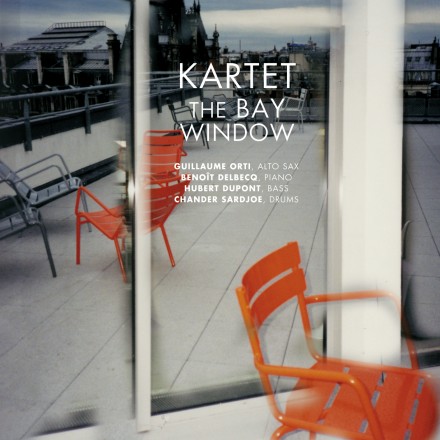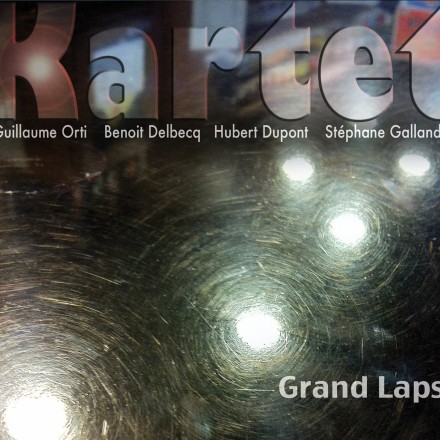Kartet
The Bay Window
SGL SA1560-2“…music in continuous metamorphosis as it pivots around the four players, and results in many simultaneous and complementary points of view on the same reality; a music which reconciles intellect and intuition as it combines a quasi-mathematical rigour with a sensitivity, an instrumental originality, and an attention to detail forged by the supreme exercise of total improvisation.”
—Stéphane Ollivier, Jazz Magazine
Kartet’s music is angular, tonally open, polyrhythmically swinging, and very polished. Their radical reworking of Monk’s “Misterioso” has a trancey, moonlit dream-logic – Parisian Third Stream. The whole album is a sensuous deep listening experience with a unique weave of forms and colors – Benoît Delbecq’s prepared piano patterns mesh with Guillaume Orti’s sinuous alto sax lines, Hubert Dupont’s anchoring bass and Chander Sardjoe’s complex timekeeping.
Kartet was formed in Paris in 1989-90. Four musicians ranging in age from 20 to 32 came together in a heady musical environment of jazz players from everywhere (and influences such as Steve Coleman’s M-Base and Steve Lacy), contemporary classical music (Messiaen, Ligeti), African music…. As Hubert Dupont says, “[When] I moved to Paris I was expecting a serious meeting, strong musical connection, a group story, and it happened. We stayed together a year in the south of France, developing collectively our compositional tools, our improvising technique…. The sound and atmospheres of the band are still a result of this.” In 1996 the Indo-Dutch drummer Chander Sardjoe replaced the original drummer Benjamin Henocq. Sardjoe has studied South Indian (Carnatic) music, and its complex subdivisions fit right in with Kartet’s polyrhythmically swinging group approach. This is their fifth CD, the first for a non-French label.
The name Kartet signifies a quartet with a difference, or many differences. Listen to “Misterioso” – there’s Monk’s characteristic melody, or parts of it, and his harmonic structure, but Benoît Delbecq has overlaid a new and more complex countermelody, one that turns the song into something else entirely and yet is somehow fitting, with distant echoes of bop filtered through all the years of music between then and now. Ongoing transformation is an important aspect of this music – “mutations” triggered by operational cues and group inspiration, not by elaborate charts or soloists taking center stage. The shifting center here is the “atmospheres,” the places the music gets taken to. Stylistically, in its melodic angularity and open tonality, its precise weaving of textures and motifs in different rhythms and tempos, the only music Kartet’s really resembles is music its members make in other contexts. But Dupont underlines the democratic nature of their process: “The best situation is when the written material looks simple, just enough to suggest the game to play, and then everybody digs, finds some stuff to do. When you compose, you may establish the rules of a game, and sometimes the game might be tricky; but at the same time, everyone has a part in the play, and you should let everyone improvise variations using his own language, tools, colours, otherwise it’s not fair. Even a newcomer in the band should feel comfortable with this. If we were a sect, and if only members of the sect could sit in, it would be the wrong train.”
It’s easy enough to hear the sophisticated rapport that allows them to negotiate what Ollivier calls “the mobile architecture of the compositions” almost intuitively. (Dupont: “Improvising on this kind of 3-D ground with collective consciousness and interplay is sometimes a funny headache at first, but sometimes it feels surprisingly easy. We’ve been playing together for so many years…”) More mysterious are the emotional effects of the music’s dream logic, because this is both a sensuous and a deep listening experience. “We want to create music that invokes a special attitude from the players as well as from listeners. It has to do with abstraction, an enigmatic atmosphere ? this should be because something is really happening and you don’t need to know and understand how it works. Then, emotion should happen in the playing – as a result of deep focus, or of total abandon?” As for the future: “Kartet 2007 sounds different from two years ago, new songs and new processes are going on, so I am optimistic.”
The Bay Window was recorded and mixed in Paris using the same engineer and studio as Delbecq’s Pursuit and Phonetics as well as his second collaboration with Vancouver clarinetist François Houle, Dice Thrown.
More info: hubertdupont.com/Kartet.htm, delbecq.net, guillaumeorti.com.

